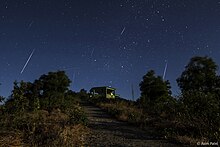Geminids
|
Meteor shower Geminids |
|
|---|---|

|
|
| Radians of the Geminids | |
| activity | |
| Beginning | December 4th |
| maximum | December 14th |
| end | 20th of December |
| Radian position | |
| RA | 7 h 28 m |
| DE | + 33 ° |
| ZHR | 150 |
| Population index | 2.6 |
| geocentric speed |
35 km / s |
The Geminids are the strongest to second strongest meteor shower of the year with a maximum around December 14th. Its radiant (the point from which the falling stars seem to come from) lies just north of the bright star Castor (α Geminorum) in the constellation Gemini ( Latin géminī ), which gave them their name.
Observation conditions
The Geminids are particularly impressive because they produce many bright, typically yellow-white glowing meteors. Since the radiant faces the sun in the sky in mid-December , it can be found over the horizon throughout the night . The maximum position is reached shortly after midnight. Therefore, in contrast to some other meteors , the Geminids can also be observed in the evening hours.
The brightest meteors typically only appear after the maximum, while the weaker objects dominate before that. A sorting of the particle sizes has therefore taken place within the meteor shower (and thus the causative orbit of the particles). The ascent to the maximum of activity is quite slow over several days, but then the descent is fairly rapid.
The activity of the Geminids has increased continuously in the last decades and now exceeds that of the Perseids in August (these are, however, observed much more frequently because of the warmer season). With average observation conditions it is about 30 to 60 per hour on December 13th and 14th.
The maximum zenithal hourly rate (ZHR) has developed in recent years from around 160 geminids per hour in 2013 and 2014, after increasing to almost 200 in 2015, back to around 150 and 140 in 2016 and 2017, respectively Proximity to the city ( limit brightness approx. 4 mag) can only be seen about 20 per hour.
Body of origin
The original body of the Geminids is a celestial body classified as an asteroid called (3200) Phaethon , which is why the Geminids can be considered an ecliptical meteor shower . Phaethon's orbit around the sun is very similar to that of a comet , apart from the short orbital period of only 1.43 years . It has been assumed on various occasions that Phaethon is an "extinct" comet that has already completely lost its volatile components (gas and dust) and is slowly "crumbling". In 2013, the evaluation of measurements showed STEREO - Spacecraft weak signs of matter emissions of Phaethon. This and its small mass relative to the totality of the Geminids led to the theory that an event such as e.g. B. a breakup of Phaethon could be their origin.
For the year 2024, the Japanese space agency JAXA is planning a mission to the asteroid (3200) Phaethon in cooperation with the DLR with the space probe Destiny Plus . It is hoped that the open questions about the origin of the Geminids can be clarified.
See also
Web links
- Geminids. ( Memento from December 16, 2012 in the web archive archive.today ). In: MeteorShowersOnline.com. Retrieved December 13, 2018.
- Geminids. Noticeable falling stars in December. In: AstroCorner.de. October 2, 2016, accessed December 13, 2018 .
- The Geminids. In: leoniden.net. Retrieved on December 13, 2018 (general information, history & links).
- The Geminids - shooting stars in Advent. ( Memento from December 13, 2014 in the web archive archive.today ). In: Planetarium-Wien.at. Retrieved December 13, 2018
- Space picture of the day: 200 Geminids on December 14th, 2020
Individual evidence
- ↑ IMO Meteor Shower Calendar 2020 , accessed on April 16, 2020
- ↑ Geminids 2013 campaign. Retrieved September 7, 2019 .
- ↑ Geminids 2014 campaign. Retrieved September 7, 2019.
- ↑ Geminids 2015 campaign. Retrieved December 13, 2018 .
- ↑ Geminids 2016 campaign. Retrieved December 13, 2018 .
- ↑ Geminids 2017 campaign. Retrieved December 13, 2018 .
- ↑ NASA : ScienceCasts: Rock Comet Sprouts a Tail. In: YouTube.com. Retrieved December 1, 2013.
- ↑ DESTINY + - Germany and Japan begin new asteroid mission. DLR - DLR and JAXA sign cooperation agreement. DLR, September 23, 2021, accessed on September 23, 2021 .
